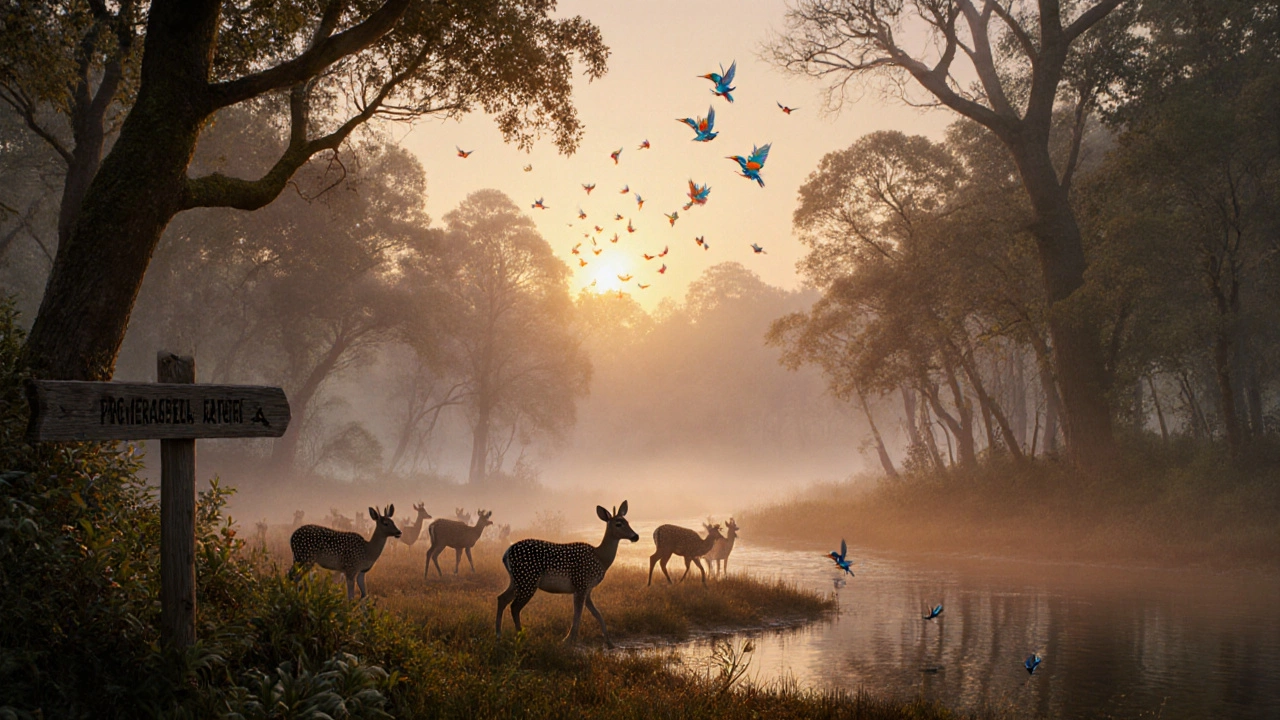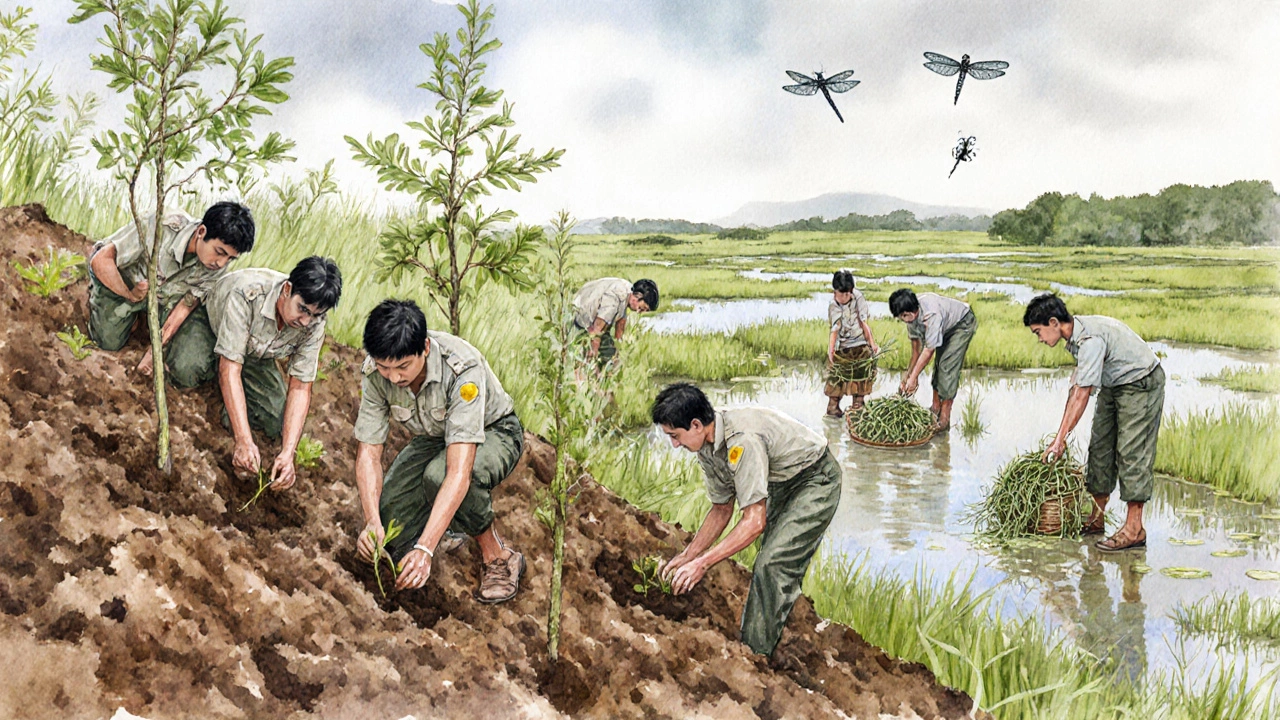What Is the Purpose of a Wildlife Sanctuary? Understanding Conservation Goals
 Oct, 20 2025
Oct, 20 2025
Protected Area Comparison Tool
Protected Area Comparison
Wildlife Sanctuary
- Primary Goal: Species-level protection
- Human Activity: Highly restricted; limited tourism
- Legal Status: Often designated by wildlife agencies
- Funding Sources: Donations, grants, ecotourism fees
- Research Focus: Facilitates scientific studies
- Community Involvement: Local partnerships for patrols
National Park
- Primary Goal: Landscape-level conservation & recreation
- Human Activity: Recreational use allowed (hiking, camping)
- Legal Status: Established by national legislation
- Funding Sources: Government budgets, entry fees
- Research Focus: Limited scientific studies
- Community Involvement: Tourism development opportunities
Nature Reserve
- Primary Goal: Habitat & ecosystem preservation
- Human Activity: Limited; research focus
- Legal Status: Can be community-driven or statutory
- Funding Sources: NGO support, research grants
- Research Focus: Primary activity
- Community Involvement: Research collaboration
Ever wondered why a piece of land is closed off to tourists, hunting, or development and labeled a sanctuary? The short answer is that a sanctuary is a safe haven for nature, but the deeper story involves a web of ecological, social, and economic reasons that keep wild animals thriving.
Key Takeaways
- A wildlife sanctuary’s main job is to protect species and their habitats from human pressures.
- It works alongside national parks and nature reserves, each with its own level of protection.
- Beyond saving animals, sanctuaries boost biodiversity, support local communities, and drive sustainable tourism.
- Effective management relies on funding, community involvement, and active habitat restoration.
- Future success hinges on connectivity, technology, and strong policy support.
Defining a Wildlife Sanctuary
When we talk about wildlife sanctuary is a protected area specifically set aside to protect wild animals and their natural habitats, we’re looking at a place where the primary focus is on the well‑being of the resident fauna. Unlike a zoo, which confines animals for display, a sanctuary keeps them in the wild but shields them from threats like poaching, habitat loss, and human disturbance.
Sanctuaries can be as small as a few hectares protecting a nesting colony, or sprawling landscapes covering hundreds of square kilometres that host entire ecosystems.
Core Purpose: Protecting Species and Habitats
The wildlife sanctuary purpose breaks down into a few concrete goals:
- Safeguarding endangered species. Many sanctuaries were created to give a last refuge to species listed as Endangered Species by the IUCN. By restricting harmful activities, these animals get a chance to recover.
- Preserving critical habitats. Whether it’s a mangrove swamp, a grassland, or a cloud forest, protecting the physical environment means the whole food web stays intact.
- Facilitating scientific research. Researchers can study animal behavior, genetics, and ecosystem dynamics without the noise of human interference.
- Promoting education and awareness. Guided tours (when carefully managed) let visitors see the value of conservation first‑hand.
How Sanctuaries Fit Within the Protected‑Area Landscape
Sanctuaries aren’t the only type of protected land. To see where they stand, compare them with national parks and nature reserves.
| Aspect | Wildlife Sanctuary | National Park | Nature Reserve |
|---|---|---|---|
| Primary Goal | Species‑level protection | Landscape‑level conservation & recreation | Habitat & ecosystem preservation |
| Human Activity | Highly restricted; limited tourism | Recreational use allowed (hiking, camping) | Limited; research focus |
| Legal Status | Often designated by wildlife agencies | Established by national legislation | Can be community‑driven or statutory |
| Funding Sources | Donations, grants, ecotourism fees | Government budgets, entry fees | NGO support, research grants |

Beyond Conservation: The Extra Benefits of Sanctuaries
Saving animals is just the first ripple. Sanctuaries generate a cascade of positive outcomes:
- Biodiversity boosts. By protecting keystone species, sanctuaries help maintain ecosystem resilience, which in turn supports pollination, water purification, and soil health.
- Ecotourism opportunities. Well‑managed visitor programs bring revenue to nearby villages while educating tourists about Ecotourism principles.
- Community empowerment. When locals are involved in Community Involvement projects-like guide training or handicraft sales-they gain alternative livelihoods that reduce reliance on hunting or logging.
- Climate mitigation. Protected forests store carbon, and healthy wetlands filter floodwaters, offering ecosystem services that benefit society at large.
Managing a Sanctuary: Funding, People, and Habitat Restoration
Running a sanctuary is a balancing act. Here are the three pillars that keep the gears turning:
1. Conservation Funding
Money comes from a mix of government grants, private donations, and visitor fees. Some sanctuaries adopt a “pay‑what‑you‑can” model that appeals to budget‑conscious travelers while still covering basic costs.
2. Community Involvement
Successful sanctuaries invite neighboring communities to co‑manage the land. Programs can include:
- Training local rangers to patrol against poaching.
- Creating job‑sharing schemes for habitat‑restoration work.
- Hosting school outreach events that teach kids about native wildlife.
3. Habitat Restoration
Even protected land can degrade. Restoration projects often focus on:
- Planting native trees to reconnect fragmented forests.
- Removing invasive species that outcompete local flora.
- Re‑wetting drained peatlands to revive carbon‑rich ecosystems.
These actions directly support Habitat Restoration goals and improve the chances of long‑term species survival.
Common Challenges Facing Sanctuaries
No sanctuary is immune to hurdles. The most frequent pain points include:
- Poaching pressure. Even with rangers on duty, illegal hunting can slip through if funding or training is insufficient.
- Insufficient financing. Grants are competitive, and tourism can fluctuate with global events, leaving budgets uncertain.
- Climate change. Shifting rainfall patterns can alter habitats, forcing species to move outside the protected boundaries.
- Human‑wildlife conflict. As populations grow, animals may raid crops or livestock, sparking tension with farmers.
Addressing these issues requires adaptive management, stronger law enforcement, and collaborative planning with local stakeholders.

Looking Ahead: The Future of Wildlife Sanctuaries
What will sanctuaries look like in the next decade? Here are three trends shaping their future:
- Landscape connectivity. Conservationists are linking isolated sanctuaries with wildlife corridors, allowing species to roam and breed across larger areas.
- Technology integration. Drones, camera traps, and AI‑driven monitoring give rangers real‑time data on animal movements and illegal activities.
- Policy reinforcement. International agreements, such as the Convention on Biological Diversity, push governments to expand protected‑area networks, giving sanctuaries more legal backing.
When these pieces click together, sanctuaries become more resilient, effective, and inclusive.
How You Can Support Sanctuaries
If you’re inspired to help, consider these practical steps:
- Visit a sanctuary responsibly-stay on marked trails, follow guidelines, and respect wildlife.
- Donate to reputable conservation NGOs that fund sanctuary projects.
- Volunteer for habitat‑restoration days or citizen‑science monitoring programs.
- Spread the word on social media, highlighting success stories and urgent needs.
Every action, big or small, adds up to a stronger safety net for the planet’s wild inhabitants.
Frequently Asked Questions
What is the legal difference between a wildlife sanctuary and a national park?
A wildlife sanctuary focuses primarily on protecting specific species and their habitats, often imposing stricter limits on human activity. A national park, while also protecting nature, is usually designed for broader ecological preservation and public recreation, allowing more tourism and educational use.
Can tourists visit wildlife sanctuaries?
Many sanctuaries permit limited, guided visits that support conservation funding. However, access rules vary; some sites are off‑limits to protect very sensitive species.
How are sanctuaries funded?
Funding typically comes from a mix of government grants, private donations, entry fees, and sometimes revenue from eco‑lodges or merchandise. Grants from international bodies like the Global Environment Facility also play a role.
What role do local communities play?
Communities can be stewards, providing patrols, traditional knowledge, and sustainable livelihood options that reduce pressure on wildlife. Successful sanctuaries often have co‑management agreements with nearby villages.
Why is habitat restoration important inside sanctuaries?
Restoring native vegetation and removing invasives revives the natural food web, giving endangered species the resources they need to breed and thrive. It also improves ecosystem services like water filtration.